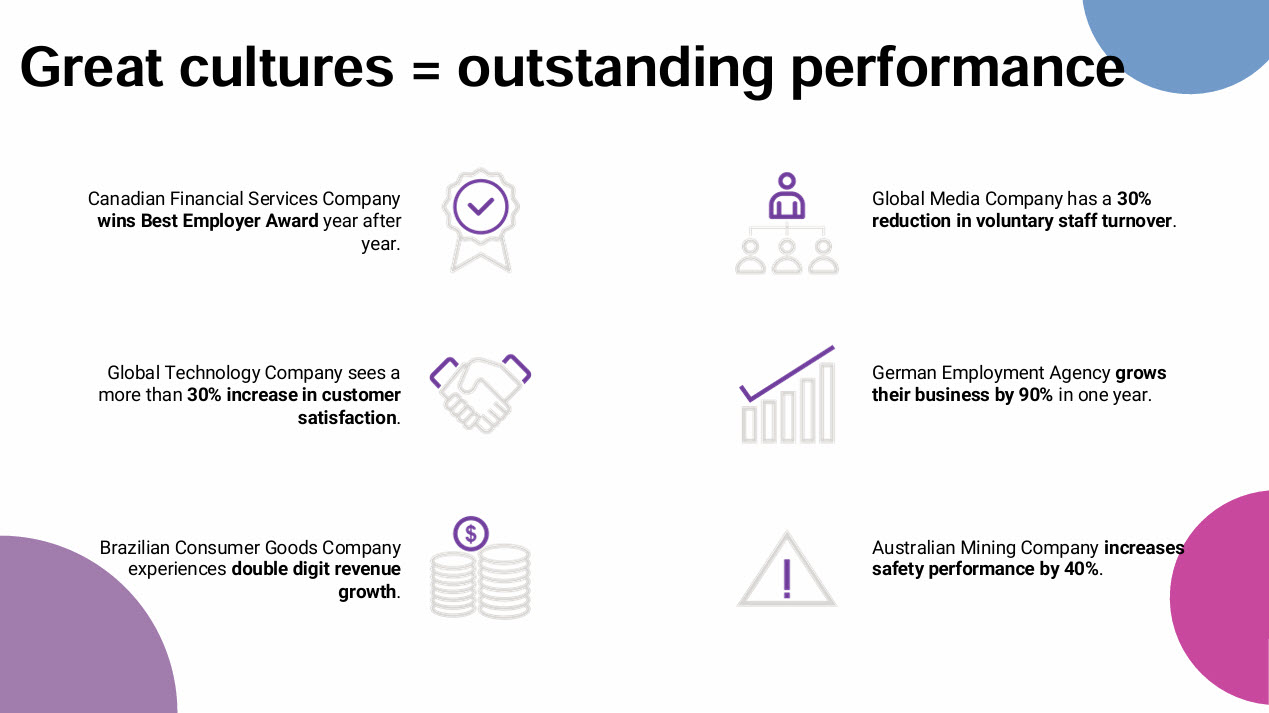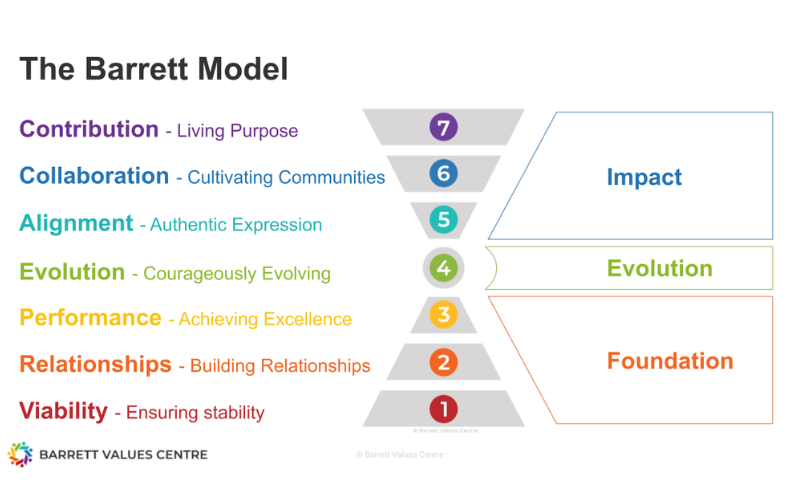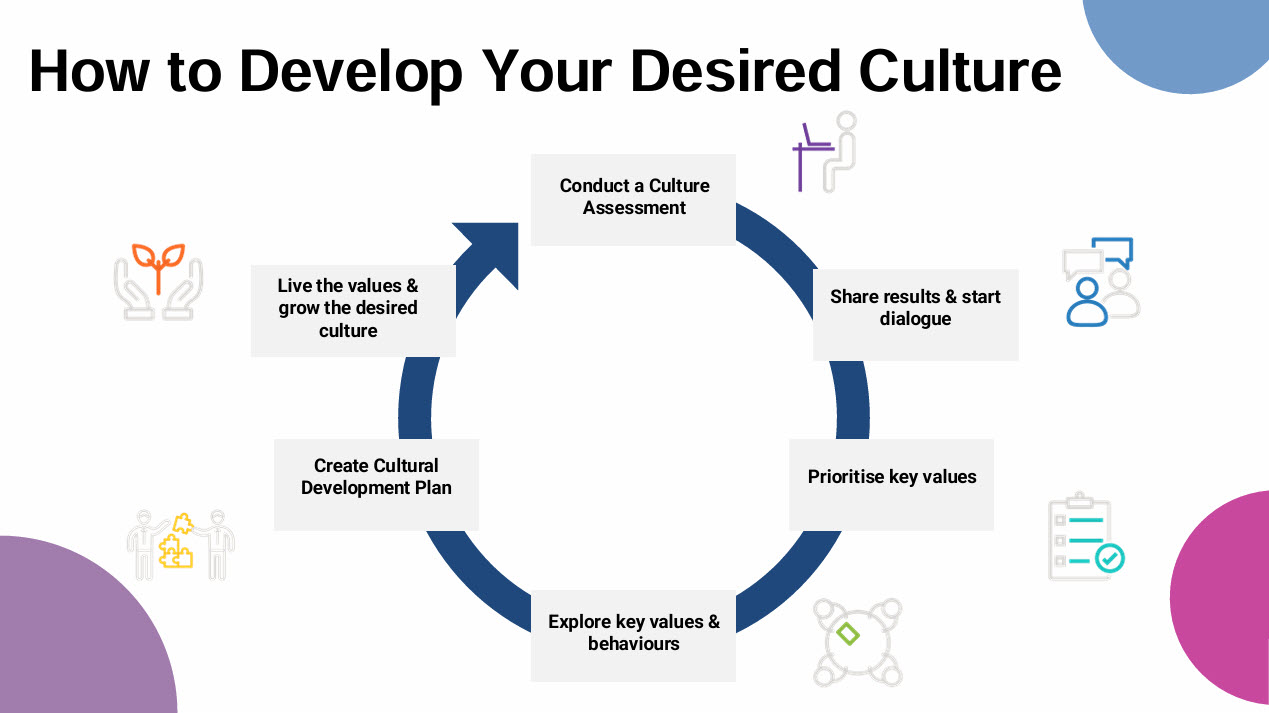
What Are Culture Change Models?
Organisational culture determines how people interact, make decisions and deliver value in a workplace.
A good culture creates engagement, innovation and alignment to strategic goals. But when culture becomes a barrier, whether through misalignment, disengagement or resistance to change, it can hold organisations back from reaching their full potential. That’s where culture change models come in.
Culture change models are structured frameworks that help organisations understand, shift and align their cultural elements to desired outcomes. They give leaders and teams the tools to diagnose the current cultural landscape, identify gaps and create action plans for transformation.
Why Are Culture Change Models Important?
Culture change is a complex process involving deeply ingrained beliefs, behaviours and systems. Without a clear framework these elements can feel intangible and overwhelming to address. Culture change models simplify this complexity by:
- Providing diagnostic tools to assess the current state of organisational culture.
- Giving strategic clarity for aligning values, practices and goals.
- Ensuring a systematic approach that engages all levels of the organisation.
- Enabling leaders to track progress and measure the impact of change initiatives.
Organisations have big goals that require not just operational changes but also changes in how people think and act. For example a company may want to be innovative but has a risk averse culture.
Culture change models are the bridge, turning strategic aspirations into behaviours that deliver results.

5 Popular Culture Change Models: An Overview
Organisations looking to change their culture have many models to choose from, each with their own perspective and approach. Below is an overview of some of the most well known culture change models and what they are all about.
1. Hofstede’s Cultural Dimensions
Geert Hofstede’s model looks at how national and regional cultural differences impact workplace behaviour.
It identifies 6 dimensions of culture, such as individualism vs collectivism and uncertainty avoidance, to help organisations navigate cross cultural challenges.
Application: For multinational companies looking to bridge cultural gaps and create global teams.
Advantages & Disadvantages
Provides a detailed framework for understanding cultural diversity.
Useful for addressing cross-border organisational challenges.
Promotes inclusivity in multinational operations.
Limited focus on organisational dynamics beyond national culture.
Does not address individual or subcultural differences within organisations.
May oversimplify complex cultural traits into broad categories.
2. Schein’s Model of Organisational Culture
Edgar Schein’s model looks at culture as a layered construct:
- Artifacts: Visible elements like office layout and dress codes.
- Espoused Values: Officially stated beliefs and values.
- Basic Underlying Assumptions: Unspoken, deeply ingrained perceptions.
Application: For diagnosing and understanding both visible and hidden cultural elements that drive behaviour.
Advantages & Disadvantages
Offers a comprehensive understanding of cultural layers.
Addresses deep-seated issues by focusing on underlying assumptions.
Encourages reflection on the alignment between stated and actual values.
Complex and time-intensive to analyse and implement.
Provides limited guidance on action steps after diagnosis.
Requires skilled facilitators for effective application.
3. The Competing Values Framework (CVF)
This model categorises organisational culture into 4 quadrants:
- Collaborate (Clan): Focused on teamwork and cohesion.
- Create (Adhocracy): Prioritising innovation and adaptability.
- Control (Hierarchy): Emphasising structure and consistency.
- Compete (Market): Driven by results and competitiveness.
Application: To balance competing priorities and identify dominant cultural traits.
Advantages & Disadvantages
Provides a clear framework for understanding organisational priorities.
Encourages a balance between flexibility and stability.
Supports leadership in identifying cultural strengths and weaknesses.
May oversimplify organisational dynamics into rigid categories.
Requires careful interpretation to avoid promoting conflicting goals.
Less effective for addressing deeper value-based issues.
4. The Denison Model
The Denison Model links organisational culture with business performance, for:
- Mission: Clear purpose and strategy.
- Consistency: Systems and values.
- Involvement: Employee engagement and empowerment.
- Adaptability: Response to external change.
Application: A practical way to measure cultural impact on performance metrics.
Advantages & Disadvantages
Directly connects cultural attributes to measurable business outcomes.
Balances internal focus with adaptability to external changes.
Provides actionable insights for driving employee engagement.
May not capture nuances of deeper cultural dynamics or values.
Best suited for performance-focused transformations rather than purpose-driven ones.
Requires consistent data collection and analysis to be effective.
5. The Barrett Values Model
The only culture change model that puts values at the centre, the Barrett Values Model identifies current and desired values to align leadership and behaviour with long term goals.
Application: For purpose driven organisations wanting to create cultures of trust, collaboration and sustainability.
Advantages & Disadvantages
Focuses on the deeper alignment of personal and organisational values.
Encourages long-term cultural sustainability and resilience.
Provides a people-centred approach to transformation.
Heavily reliant on leadership buy-in and active participation.
Requires robust communication and engagement strategies to succeed.
May be less effective for addressing operational or performance-centric issues alone.
Which Model to Choose
All culture change models are useful but the choice depends on the organisation’s goals, challenges and context. For example:
Hofstede and Schein are good for understanding cultural roots and dynamics. CVF and Denison are for balancing priorities and aligning culture with performance. The Barrett Values Model is unique in its focus on deep seated values and personal alignment. Now you can choose a model, or combination of models, to support your transformation journey.
The Barrett Values Model: A Deep Dive
As organisations try to adapt and survive in a changing world, aligning their culture to their values has become more critical.
The Barrett Values Model is one of the most popular culture change models and it’s unique in that it starts with values as the foundation of organisational transformation.
Values drive decisions, behaviours and organisational priorities. Misaligned values lead to disengagement, inefficiency and resistance to change. The Barrett Values Model identifies and maps the current cultural values and the desired future state and creates a clear path for transformation.
The Seven Levels of Consciousness
At the heart of the Barrett Values Model are the Seven Levels of Consciousness which apply to individuals, teams and organisations. Each level has its own set of priorities and behaviours:
- Viability: Focuses on basic needs such as financial stability and health.
- Relationships: Emphasises interpersonal connections, trust, and communication.
- Performance: Centers on achieving excellence, recognition, and status.
- Evolution: Encourages adaptability, continuous learning, and innovation.
- Alignment: Highlights finding meaning, shared vision, and values alignment.
- Collaboration: Involves social responsibility, community contribution, and ethical practices.
- Contribution: Represents selfless service, commitment to humanity, and environmental sustainability.
How It Works
The Cultural Values Assessment (CVA) is the foundation of the Barrett Values Model. This diagnostic tool gathers input from employees at all levels, mapping:
- Current Values – What employees see as the current culture.
- Desired Values – What they want the culture to be.
- Entropy Levels – Where the dysfunction or misalignment is, often expressed as bureaucracy, conflict or fear.
By comparing current and desired values organisations can see where to focus their cultural change efforts.
What sets the Barrett Values Model apart is its people centric approach. By aligning personal and organisational values it creates a deeper sense of belonging, motivation and engagement. Other models focus on processes or behaviours, this model recognises the intrinsic link between human values and organisational success.
Primeast’s Use of Barrett Values
At Primeast we use the Barrett Values Model to:
- Align Leadership: Help leaders live and breathe the desired culture.
- Build Trust and Engagement: Align personal and organisational values to create collaboration and loyalty.
- Drive Purposeful Transformation: Ensure the cultural change supports long term strategic goals.
By anchoring culture change in values, organisations can create a foundation for innovation, growth and resilience.
Choosing the Right Culture Change Model
Choosing the right culture change model is key to any organisational transformation. It requires careful thought about the size of the organisation, the challenges you’re facing and the end goal of the cultural change programme.
Understanding Organisational Context
For larger more complex organisations the biggest challenge is often cultural differences across regions or departments. With mergers and acquisitions there can be multiple cultures playing out against each other creating tension and conflict. Subcultures commonly occur in all organisations and the Barrett Values Assessments enable enterprise wide measurement with data cuts and targeted diagnosis which can help to prioritise key focus areas and ultimately hep in creating greater cultural synergy across organisations.
Models like Hofstede’s and Denison’s can be used in more granular situations during team development or leadership workshops informing study of intrinsic and extrinsic motivations and practices.
Identifying the Challenge
The type of challenge your organisation is facing and use-case will influence the choice of model. If inefficiencies or inconsistent processes are the root cause then the Denison Model’s focus on adaptability and mission clarity will be a practical solution.
But if unspoken norms and deeply held beliefs are driving behaviour then Schein’s Model is particularly useful. By helping organisations uncover those hidden assumptions this model provides a foundation for real change.
Aligning with Organisational Objectives
Your objectives for cultural transformation will also influence the choice of model. For organisations looking to innovate and be creative the Competing Values Framework (CVF) highlights the cultural dynamics that drive adaptability and agility.
For organisations looking to build trust, engagement and alignment with core values the Barrett Values Model is the best. Its focus on creating a values driven workplace means employees feel motivated and connected to the organisation’s purpose.
Evaluating Leadership Readiness
Any culture change effort hinges on the readiness and commitment of leaders. Leadership alignment is a key component of the Barrett Values Model which provides tools to help leaders live the organisation’s values and build trust during change.
A supportive and engaged leadership team can be the difference between a successful transformation and a stalled programme.
Combining Models for Better Outcomes
In some cases combining models can be a more comprehensive approach. For example Schein’s Model can diagnose the existing cultural layers and the Barrett Values Model can align those layers to the organisation’s desired future state.
Blending the structural focus of the CVF with the purpose driven approach of Barrett Values can balance innovation with long term objectives.
Choosing the right culture change model is about more than solving the immediate challenge, it’s about building a sustainable culture.
By evaluating the organisation’s context, priorities and readiness leaders can choose a model, or a combination of models, that will support long term success.
Action Plan: Implementing Culture Change with Models

Understanding the models is only the first step; the real work is in implementing them within your organisation.
Success requires a structured approach that links leadership, engages employees and measures progress towards the desired cultural shift.
Step 1: Diagnosing the Current Culture
Before you start any change initiative you need to understand the current cultural landscape. Tools like the Barrett Cultural Values Assessment (CVA) or Schein’s artifacts analysis will show you what drives behaviour, the underlying values and the gap between leadership and teams.
This diagnostic phase provides the foundation for informed decision making and targeted interventions.
Step 2: Engaging Leadership
Alignment is key to cultural transformation. Leaders need to not only understand the desired culture but also model it through their behaviour and decisions.
The Barrett Values Model for example puts a strong emphasis on helping leaders embody shared values so they become role models for the rest of the organisation. When leadership is aligned it builds trust and credibility and opens up the organisation to cultural change.
Step 3: Developing a Clear Plan
Once the current culture is mapped and leadership is aligned the next step is to develop a plan. This means setting priorities based on the chosen culture change model. For example if using the Competing Values Framework (CVF) the organisation may decide to prioritise innovation or collaboration and develop initiatives to build the behaviours that support those goals.
A plan should have measurable objectives, specific timelines and milestones to measure progress and flexibility to adapt to the unexpected.
Step 4: Engaging Employees
Cultural transformation can’t happen without the workforce. Clear and transparent communication about the “why” behind the change is key.
Employees need to know how the change aligns to the organisation’s purpose and how it benefits them personally. Using values as a foundation as in the Barrett Values Model will create a shared sense of purpose and emotional investment in the change process.
Practical actions include workshops, feedback sessions and interactive activities that reinforce the desired values and behaviours. When employees feel involved and valued they will be more likely to engage in the transformation.
Step 5: Monitoring and Refining
Cultural transformation is not a one off initiative but an ongoing process.
Regularly measuring progress using tools like CVA or the Denison Organisational Culture Survey will keep the transformation on track. Metrics such as employee engagement, retention rates and productivity will be indicators of cultural health.
Organisations should be open to refining their approach. Feedback loops from employees or leadership will provide valuable insights to inform adjustments to the plan. Continuous learning and adaptation is key to embedding lasting change.
Implementing culture change models is more than just ticking boxes, it requires commitment at every level of the organisation.
By following a structured approach and using proven frameworks like the Barrett Values Model you can ensure your cultural transformation is successful and sustainable and provides a foundation for long term growth and alignment.
Building a Values-Driven Culture for Long-Term Success
Culture is at the core of every successful business, how teams work together, innovate and achieve their goals. By using culture change models, organisations get the tools and insights to navigate transformation effectively. These models give clarity, structure and direction so leaders can align behaviours and practices to organisational aspirations.
Among the many frameworks out there the Barrett Values Model stands out for its focus on values as the foundation of culture. It’s a transformative approach not just addressing surface level behaviours but also getting deep alignment between individual and organisational priorities.
This values driven approach creates a culture that’s resilient, engaged and purposeful so it lasts.
But no one model fits every organisation. Choosing the right framework depends on your organisation’s unique challenges, goals and context. Whether it’s the innovation focused Competing Values Framework, the diagnostic depth of Schein’s Model or the performance focused Denison Model the key is to choose a model, or combination of models, that aligns to your future vision.
At Primeast we specialise in guiding organisations through their cultural transformation journey. By listening deeply, diagnosing challenges and tailoring solutions to your context we help you get sustainable results.
Whether you’re embarking on a values driven transformation or a broader culture shift we’re here to support you every step of the way. Contact us today.



